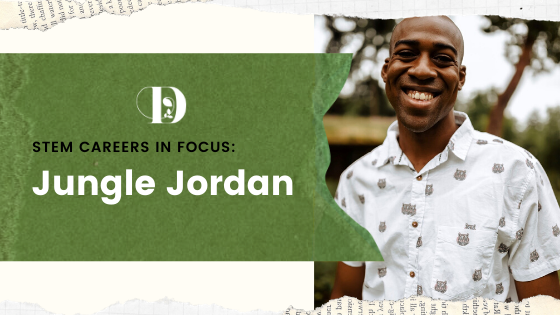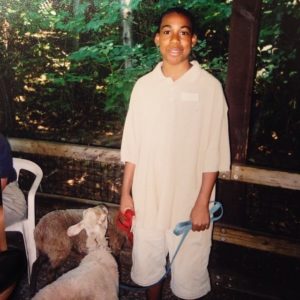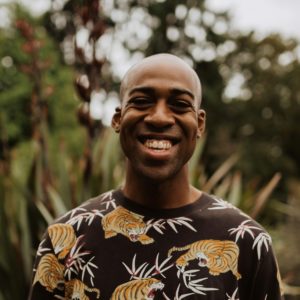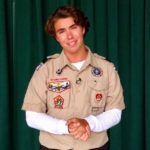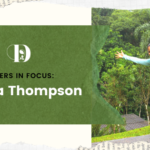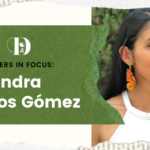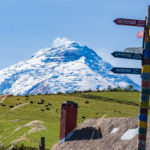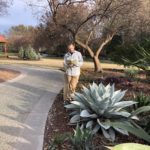STEM Careers in Focus: Jungle Jordan
Our robust Children’s Adventure Garden programming often features both local and national STEM personalities for on-site events. During our closure, we’ve worked hard to keep you connected to our interactive content, and this week we bring an interview with Jordan Veasley, known by his masses of social media fans as Jungle Jordan. Our Director of Experience and Innovation, Dustin Miller, recently caught up with Jordan to learn about his career in informal science and his newfound celebrity. Jordan is our first in a series of interviews for kids and parents, STEM Careers in Focus.
Dustin Miller (DM): Jordan, tell me about your experiences in nature growing up. I’ve seen your zoo volunteer photo as a pre-teen, but what got you to that point?
Jungle Jordan (JJ): I would say when I first started liking animals it comes from being in my backyard looking for little bugs, seeing all the cool birds that fly by, even animals like squirrels. I think one of the biggest things that started it for me was seeing this nesting pair of eagles in my backyard. They’d come back every single year to raise their babies. The babies hatch, they grow up and fly together and they eventually fly off and do their own thing. So that was one of the coolest things. Growing up watching movies, like Free Willy. Everything was animal themed, and I was like, “I wanna do this. I want to work with these animals.’’ I didn’t let anything stop me.
DM: So you started volunteering in zoos at the age of 11, right? Tell me about young Jordan.
JJ: Growing up I used to have anger management problems…and it was very different for where I grew up for someone like me to like animals. It was very weird.
People thought it was weird, and they also thought it was funny to watch me get angry. So they would try to tease me to make me angry and see how fast I would get angry. So, I got into a lot of trouble. I get expelled from school, suspended, fights, kicking over desks, things like that…
But my mom always knew that I loved being around animals and that I was always happiest at the zoo. So she tried to connect with the Woodland Park Zoo to see if they’d take an 11-year-old volunteer … which was not a thing. So she pleaded and pleaded and pushed and pushed and they said, “Yes, he can do it as long as we have a chaperone for him.”
So the chaperone was a zookeeper that was watching me on the family farm and she was like my guardian angel watching over me, training me with sheep and goats and all these different things. So that was my first look into zookeeping … and I always knew zookeeping was my path since then.
Even before that, though, my dream was to have a TV show – to have an animal show and be like Jeff Corwin or Steve Irwin, but that was like a joke. But I feel like that might become a thing!
DM: How long were you a volunteer at the zoo?
JJ: Oh my goodness, I was a volunteer all the way from when I was 11 until about 17. They started a teen program called Zoo Corps because they knew they had teens that wanted to be volunteers and I was almost a pioneer, myself and another kid, we were pioneers for this program.
[Then I went to college] and I got this job as exhibit attendant, which is like a keeper’s aide at Woodland Park Zoo – [all this experience] was at Woodland Park Zoo. I did my senior thesis at the Woodland Park Zoo on the Komodo dragon. It was on environmental enrichment, so I got to be in with the Komodo dragons and that was SO COOL. I did some work with them to see if I could increase their activity level during the day.
I graduated, and did another internship at Point Defiance [Zoo] while I was working at Woodland Park Zoo as an exhibit attendant and I was really grinding. So zoos have been my whole life basically.
DM: What changes have you seen in the zoo world since you became a keeper?
JJ: I have noticed a change in public perception. I’ve seen a weird cycle. So before they were showing things behind the scenes. I used to watch all these old videos…from watching these videos from the 80s I feel like they wanted things to be transparent, they wanted people to see what was happening behind-the-scenes. And then they changed that and went to “hey, we can’t show people what’s happening at all” and then it became very entertainment based – like “we have to have a SHOW.”
And now it’s going back to showing what’s behind the scenes and showing more of what’s happening with conservation efforts – and that’s pretty awesome to see that people are understanding, more and more as the years go by, that even with things like Blackfish coming out, people are understanding what … good accredited zoos and facilities are doing for conservation and wildlife. All these things have been going on for years; it just wasn’t in the forefront. It wasn’t being video recorded and live streamed … technology is crazy advanced right now and its showing what is happening. It’s pretty amazing.
DM: I feel like the same is true with animal names – whether zoos share those with the public shifts in and out of favor.
JJ: People feel this attachment when they’re able to actually know the animal’s name or behavior or something special about that animal.
DM: When did you become Jungle Jordan?
JJ: I made my channel in 2016, but I didn’t become Jungle Jordan until the end of 2017. But it wasn’t approved on all my platforms until 2018. For some reason Facebook wouldn’t let me change my name. They kept saying, “You’ll confuse your followers.” I was like, “No, I’m the same person. I’ve been going by this name on my channel, but the name of my channel doesn’t say Jungle Jordan. THAT confuses people.”
It got started for a reason. I wanted to put more of a focus on diversity. I was getting tired of what was happening to me in the field. No physical altercations or anything like that, but lots of verbal – and not being recognized. So I said, “Hey, Jungle Jordan is who I am and this is what you guys need to see. I work with animals. Get used to it.”
Jungle Jordan is just a persona that people can hold on to. I feel like it adds a level of fun because it’s a nickname. We’re the same person. I’m Jungle Jordan. Jordan Veasley. That’s me. I don’t want people to think I’m conceited or really into myself, [but] I do have guests come to the zoo and recognize me. When I was at Woodland Park [Zoo], the volunteers really loved the whole Jungle Jordan idea. They really loved that whole thing! But I try to be humble. People tell me I should brag more about myself, but it’s just weird…
DM: Wait, are you trademarked?
JJ: [Laughs] Actually, I’m in the process of that, yes.
DM: What got you into YouTube?
JJ: Technically, I’ve been doing YouTube videos since 2012. I was doing YouTube videos with Woodland Park Zoo when I was an exhibit attendant. My first video was on Komodo dragons … and it was just bad on my part. The acting was so horrible. It was bad. But the video was educational. It was a good video.
When I first started my YouTube channel … I had these two friends that were big YouTubers. They had a million plus subscribers at the time. They have over two million now … and they helped me get my channel started. I was in a lot of their videos and their audience knew who I was, but their videos weren’t about animals. We were trying to introduce that slowly to not confuse their followers.
I was also into shoes. I was big into basketball shoes and collecting them. I was just big into basketball, so my old videos were about that … with the occasional animal video thrown in there – which is my actual passion – just to see what people would think. They got way less views than the basketball stuff … and I was like this is not what I want to do. I was bored making sneaker videos. I mean I like playing basketball, but that wasn’t what I wanted to do. I wanted to tell people about animals. So I just made this crazy switch … to Jungle Jordan, and people were like, “Whoa! Who are you? I’m out of here!”
YouTube is a weird space, though. I feel like I get the most love from Instagram … and TikTok apparently now. People love me on TikTok!
One thing I’ve noticed with all my channels, I have very nice people following me. My YouTube friends always tell me how surprised they are with my comment section … Mine is very, very positive. I’ll rarely have a negative comment, maybe I just bring the positive people.
DM: What do you think your most important message is?
JJ: Follow your passions and don’t let anything steer you away from them. I feel like people get deterred from following their passions or things that they love because people tell them they shouldn’t do it.
For me, growing up, because I was Black and smart, they said, “Hey, you shouldn’t throw away your smartness to work with animals. You’re going to be the first one from our family to graduate from college – or even go to college – you should be a lawyer or a doctor or whatever.” No offense to lawyers or doctors. They’re awesome. My mom was the only person who said, “Do what you want to do.”
One of my biggest things is representation in this field. People see me. Kids of color can see me, and they say, “Hey wait, maybe I can do this, too. If he’s doing it …” They didn’t know it was an option.
When I was a kid, people didn’t know it was an option to work with animals. People fear the unknown and people, where I grew up, were scared of animals because of what they see on TV and in movies.
I just want people to see that these animals are here. They were here before us. We can live them and we’ve got to take care of them. So – diversity and animal care – those are big deals for me.
DM: How can parents support kids that want to get into nature?
JJ: Be just like my mom: If they don’t want to do it, don’t force them to do it. Not all kids have to be out in nature. It’s not for everybody, but it’s a good way to appreciate it.
If you show them your personal passion, passion is contagious … it spills out. That’s what people see with me. I love what I’m doing so much, that people can’t help but to love it to. I feel like if parents show how much they love it, it will go on [to their kids].
So if your kid comes to you and says, “I want to go on this hiking trip,” don’t just say, “No, we don’t do that kind of thing.” My mom was very positive – let me do hiking trips, let me do camping trips, let me learn how to snowboard. Because when we grew up, African Americans didn’t snowboard, ski … extreme sports weren’t us. I wanted to learn how to do motocross, but that was too expensive. My mom said no. [laughs]
DM: So who is your audience?
JJ: With me, I feel like I have a good way to connecting with both parents and kids. My form of educating blends with both.
The main group that follows me are people my age or older with kids. Depending on the platform, on TikTok I have all younger kids. But it’s a mix. Everybody. There’s a lot of love on my page. Everyone supports everyone.
DM: Many people like you and me have memories of highlight experiences as kids in zoos, museums and gardens – but these are experiences that not everyone gets. What can we do to improve that?
JJ: That’s a tough one. I don’t feel qualified to answer that one, but I’d say throw a bunch of different [experiences] at them. A big one for me, and kids that I grew up with, is affording these experiences. A lot of these trips aren’t free. For a hiking excursion, even though you’re just going in to the wilderness – and the wilderness is free – for a lot of these kids it costs a lot of money because they have to transport you there, you know.
I feel like if there was a way to make things more affordable, more inclusive, make kids feel more welcome … make it so that it’s an open environment.
DM: As a former zookeeper, and now at the garden, I think about the opportunities that kids get to experience our institutions, such as field trips.
JJ: I’m happy you brought that up…
[As a keeper] I can easily tell the kids who are privileged enough to have gone to the zoo more than once. You see the kids that it’s their first time, they’re overly excited. They’re running around. They’re screaming because they don’t know how to contain their excitement because they’ve never been before because their parents couldn’t afford it or because they just didn’t have those opportunities, they just couldn’t get there. So, I would take advantage of those groups … to see me because a lot of them are minorities. And when they see me, they go, “Wow, he looks just like me. Maybe I could do this! Maybe we can come back.” Those kids bring that excitement home, and their parents [say], “Maybe we CAN go again.”
DM: Our professional organization, the American Public Garden Association, recently held a conference looking at wild crop diversity which brought together a number of organizations that don’t always work together – and it got me thinking: On the surface, zoos, aquariums and gardens have a lot in common – especially in their missions. How do you think they can work better together?
JJ: Zoos and gardens can go hand in hand, I feel like, because most zoos have horticulture teams that maintain the grounds of the facility with all the beautiful plants that coincide with the area. Say you have an African savannah, you have savannah looking plants and trees nearby to help blend in and a lot of the horticulture teams will provide a lot of the food for the animals at the zoo.
These animals, in the wild, also need something to eat … What are some of these animals eating? What are orangutans eating? Are they eating plant material? I feel like if you’re protecting animals, you have to protect the land. Deforestation is a huge issue … It’s a collaborative effort … What animals are benefiting from [wild] plants? … They can’t function without one another. There needs to be more of a connection [between gardens and zoos].
DM: Any parting words?
JJ: Respect wildlife. Be supportive of one another. And, just go out there and enjoy the environment.
All of Jordan’s social platforms are family-friendly, and feature some pretty cool animals:
Tiktok / YouTube / Instagram / Facebook
Written by Dustin Miller, director of experience and innovation at the Dallas Arboretum
Related Posts
Comments are closed.


